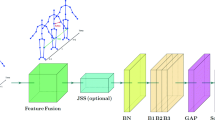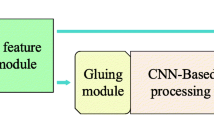Abstract
In skeleton-based action recognition, graph convolutional networks (GCNs), which model human body skeletons using graphical components such as nodes and connections, have recently achieved remarkable performance. While the current state-of-the-art methods for skeleton-based action recognition usually assume that completely observed skeletons will be provided, it is problematic to realize this assumption in real-world scenarios since the captured skeletons may be incomplete or noisy. In this work, we propose a skeleton-based action recognition method that is robust to noise interference for the given skeleton features. The key insight of our approach is to train a model by maximizing the mutual information between normal and noisy skeletons using predictive coding in the latent space. We conducted comprehensive skeleton-based action recognition experiments with defective skeletons using the NTU-RGB+D and Kinetics-Skeleton datasets. The experimental results demonstrate that when the skeleton samples are noisy, our approach achieves outstanding performances compared with the existing state-of-the-art methods.







Similar content being viewed by others
References
Atal BS, Schroeder MR (1970) Adaptive predictive coding of speech signals. Bell Syst Technic J 49(8):1973–1986
Badrinarayanan V, Kendall A, Cipolla R (2017) Segnet: A deep convolutional encoder-decoder architecture for image segmentation. IEEE Trans Pattern Anal Machine Intell 39(12):2481–2495
Bengio Y, Senécal JS (2008) Adaptive importance sampling to accelerate training of a neural probabilistic language model. IEEE Trans Neural Netw 19(4):713–722
Cao Z, Simon T, Wei SE, Sheikh Y (2017) Realtime multi-person 2d pose estimation using part affinity fields. In: Proceedings of the IEEE conference on computer vision and pattern recognition, pp 7291–7299
Cao Z, Hidalgo G, Simon T, Wei SE, Sheikh Y (2018) Openpose: Realtime multi-person 2d pose estimation using part affinity fields. arXiv:181208008
Cao Z, Hidalgo Martinez G, Simon T, Wei S, Sheikh YA (2019) Openpose: Realtime multi-person 2d pose estimation using part affinity fields. IEEE Transactions on Pattern Analysis and Machine Intelligence
Chung J, Gulcehre C, Cho K, Bengio Y (2014) Empirical evaluation of gated recurrent neural networks on sequence modeling. arXiv:14123555
Ding Z, Wang P, Ogunbona PO, Li W (2017) Investigation of different skeleton features for cnn-based 3d action recognition. In: 2017 IEEE International conference on multimedia & expo workshops (ICMEW). IEEE, pp 617–622
Du Y, Wang W, Wang L (2015) Hierarchical recurrent neural network for skeleton based action recognition. In: Proceedings of the IEEE conference on computer vision and pattern recognition, pp 1110–1118
Elias P (1955) Predictive coding–i. IRE Trans Inform Theory 1 (1):16–24. https://doi.org/10.1109/TIT.1955.1055126
Feichtenhofer C, Pinz A, Zisserman A (2016) Convolutional two-stream network fusion for video action recognition. In: The IEEE conference on computer vision and pattern recognition (CVPR)
Fernando B, Gavves E, Oramas JM, Ghodrati A, Tuytelaars T (2015) Modeling video evolution for action recognition. In: Proceedings of the IEEE conference on computer vision and pattern recognition, pp 5378–5387
Gao T, Packer B, Koller D (2011) A segmentation-aware object detection model with occlusion handling. In: CVPR 2011. IEEE, pp 1361–1368
Gao Z, Guo L, Guan W, Liu AA, Ren T, Chen S (2020a) A pairwise attentive adversarial spatiotemporal network for cross-domain few-shot action recognition-r2. IEEE Trans Image Process 30:767–782
Gao Z, Guo L, Ren T, Liu AA, Cheng ZY, Chen S (2020b) Pairwise two-stream convnets for cross-domain action recognition with small data. IEEE Transactions on Neural Networks and Learning Systems
Girdhar R, Ramanan D, Gupta A, Sivic J, Russell B (2017) Actionvlad: Learning spatio-temporal aggregation for action classification. In: Proceedings of the IEEE conference on computer vision and pattern recognition, pp 971–980
Girshick R (2015) Fast r-cnn. In: Proceedings of the IEEE international conference on computer vision, pp 1440– 1448
Gutmann M, Hyvärinen A (2010) Noise-contrastive estimation: A new estimation principle for unnormalized statistical models. In: Proceedings of the thirteenth international conference on artificial intelligence and statistics, pp 297–304
Hussain M, Chen D, Cheng A, Wei H, Stanley D (2013) Change detection from remotely sensed images: From pixel-based to object-based approaches. In: ISPRS Journal of photogrammetry and remote sensing, vol 80, pp 91–106
Jozefowicz R, Vinyals O, Schuster M, Shazeer N, Wu Y (2016) Exploring the limits of language modeling. arXiv:160202410
Kay W, Carreira J, Simonyan K, Zhang B, Hillier C, Vijayanarasimhan S, Viola F, Green T, Back T, Natsev P, et al. (2017) The kinetics human action video dataset. arXiv:170506950
Ke Q, Bennamoun M, An S, Sohel F, Boussaid F (2017) A new representation of skeleton sequences for 3d action recognition. In: Proceedings of the IEEE conference on computer vision and pattern recognition, pp 3288–3297
Kim TS, Reiter A (2017) Interpretable 3d human action analysis with temporal convolutional networks. In: 2017 IEEE Conference on computer vision and pattern recognition workshops (CVPRW). IEEE, pp 1623–1631
Li B, Dai Y, Cheng X, Chen H, Lin Y, He M (2017) Skeleton based action recognition using translation-scale invariant image mapping and multi-scale deep cnn. In: 2017 IEEE International conference on multimedia & expo workshops (ICMEW). IEEE, pp 601–604
Li M, Chen S, Chen X, Zhang Y, Wang Y, Tian Q (2019) Actional-structural graph convolutional networks for skeleton-based action recognition. In: Proceedings of the IEEE conference on computer vision and pattern recognition, pp 3595–3603
Li YM, Gao Z, Tao YB, Wang LL, Xue YB (2020) 3d object retrieval based on non-local graph neural networks. Multimed Tools Appl 79(45):34011–34027
Liu J, Shahroudy A, Xu D, Wang G (2016) Spatio-temporal lstm with trust gates for 3d human action recognition. In: European conference on computer vision. Springer, pp 816–833
Liu J, Wang G, Duan LY, Abdiyeva K, Kot AC (2017a) Skeleton-based human action recognition with global context-aware attention lstm networks. IEEE Trans Image Process 27(4):1586–1599
Liu J, Rahmani H, Akhtar N, Mian A (2019) Learning human pose models from synthesized data for robust rgb-d action recognition. Int J Comput Vis 127(10):1545–1564
Liu M, Liu H, Chen C (2017b) Enhanced skeleton visualization for view invariant human action recognition. Pattern Recogn 68:346–362
Mikolov T, Chen K, Corrado G, Dean J (2013) Efficient estimation of word representations in vector space. arXiv:13013781
Mnih A, Teh YW (2012) A fast and simple algorithm for training neural probabilistic language models. arXiv:12066426
Oord Avd, Li Y, Vinyals O (2018) Representation learning with contrastive predictive coding. arXiv:180703748
Peng W, Hong X, Chen H, Zhao G (2019) Learning graph convolutional network for skeleton-based human action recognition by neural searching. arXiv:191104131
Qian R, Meng T, Gong B, Yang MH, Wang H, Belongie S, Cui Y (2020) Spatiotemporal contrastive video representation learning. arXiv:200803800
Shahroudy A, Liu J, Ng TT, Wang G (2016) Ntu rgb+ d: A large scale dataset for 3d human activity analysis. In: Proceedings of the IEEE conference on computer vision and pattern recognition, pp 1010–1019
Shi L, Zhang Y, Cheng J, Lu H (2019a) Skeleton-based action recognition with directed graph neural networks. In: Proceedings of the IEEE conference on computer vision and pattern recognition, pp 7912–7921
Shi L, Zhang Y, Cheng J, LU H (2019b) Skeleton-based action recognition with multi-stream adaptive graph convolutional networks. arXiv:191206971
Shi L, Zhang Y, Cheng J, Lu H (2019c) Two-stream adaptive graph convolutional networks for skeleton-based action recognition. In: Proceedings of the IEEE conference on computer vision and pattern recognition, pp 12026–12035
Si C, Jing Y, Wang W, Wang L, Tan T (2018) Skeleton-based action recognition with spatial reasoning and temporal stack learning. In: Proceedings of the european conference on computer vision (ECCV), pp 103–118
Si C, Chen W, Wang W, Wang L, Tan T (2019) An attention enhanced graph convolutional lstm network for skeleton-based action recognition. In: Proceedings of the IEEE conference on computer vision and pattern recognition, pp 1227– 1236
Song S, Lan C, Xing J, Zeng W, Liu J (2017) An end-to-end spatio-temporal attention model for human action recognition from skeleton data. In: Thirty-first AAAI conference on artificial intelligence
Song YF, Zhang Z, Wang L (2019) Richly activated graph convolutional network for action recognition with incomplete skeletons. In: 2019 IEEE international conference on image processing (ICIP). IEEE, pp 1–5
Song YF, Zhang Z, Shan C, Wang L (2020) Stronger, faster and more explainable: A graph convolutional baseline for skeleton-based action recognition. In: Proceedings of the 28th ACM international conference on multimedia (ACMMM), association for computing machinery, New York, NY, USA, pp 1625–1633. https://doi.org/10.1145/3394171.3413802
Sultani W, Chen C, Shah M (2018) Real-world anomaly detection in surveillance videos. In: The IEEE conference on computer vision and pattern recognition (CVPR)
Tang Y, Tian Y, Lu J, Li P, Zhou J (2018) Deep progressive reinforcement learning for skeleton-based action recognition. In: Proceedings of the IEEE conference on computer vision and pattern recognition, pp 5323–5332
Thakkar K, Narayanan P (2018) Part-based graph convolutional network for action recognition. arXiv:180904983
Tran C, Trivedi MM (2011) 3-d posture and gesture recognition for interactivity in smart spaces. IEEE Trans Indust Inform 8(1):178–187
Vondrick C, Pirsiavash H, Torralba A (2016) Anticipating visual representations from unlabeled video. In: Proceedings of the IEEE conference on computer vision and pattern recognition, pp 98– 106
Wang C, Xu D, Zhu Y, Martín-Martín R, Lu C, Fei-Fei L, Savarese S (2019a) Densefusion: 6d object pose estimation by iterative dense fusion. In: Proceedings of the IEEE conference on computer vision and pattern recognition, pp 3343–3352
Wang L, Koniusz P, Huynh DQ (2019b) Hallucinating idt descriptors and i3d optical flow features for action recognition with cnns. In: Proceedings of the IEEE international conference on computer vision, pp 8698–8708
Wang X, Han TX, Yan S (2009) An hog-lbp human detector with partial occlusion handling. In: 2009 IEEE 12th international conference on computer vision. IEEE, pp 32–39
Wang X, Gao L, Wang P, Sun X, Liu X (2017a) Two-stream 3-d convnet fusion for action recognition in videos with arbitrary size and length. IEEE Trans Multimed 20(3):634–644
Wang X, Shrivastava A, Gupta A (2017b) A-fast-rcnn: Hard positive generation via adversary for object detection. In: Proceedings of the IEEE conference on computer vision and pattern recognition, pp 2606–2615
Xia L, Chen CC, Aggarwal JK (2012) View invariant human action recognition using histograms of 3d joints. In: 2012 IEEE computer society conference on computer vision and pattern recognition workshops. IEEE, pp 20–27
Yan S, Xiong Y, Lin D (2018) Spatial temporal graph convolutional networks for skeleton-based action recognition. In: Thirty-second AAAI conference on artificial intelligence
Yu J, Yow KC, Jeon M (2018) Joint representation learning of appearance and motion for abnormal event detection. Mach Vis Appl 29(7):1157–1170
Yu J, Park S, Lee S, Jeon M (2019) Driver drowsiness detection using condition-adaptive representation learning framework. IEEE Trans Intell Transp Syst 20 (11):4206–4218. https://doi.org/10.1109/TITS.2018.2883823
Zhang P, Lan C, Xing J, Zeng W, Xue J, Zheng N (2017) View adaptive recurrent neural networks for high performance human action recognition from skeleton data. In: Proceedings of the IEEE international conference on computer vision, pp 2117– 2126
Zhang Z (2012) Microsoft kinect sensor and its effect. IEEE Multimed 19(2):4–10
Acknowledgments
This work was partly supported by an Institute of Information & Communications Technology Planning & Evaluation (IITP) grant funded by the Korean government (MSIT) (No. 2014-0-00077, Development of global multitarget tracking and event prediction techniques based on real-time large-scale video analysis) and the National Research Foundation of Korea (NRF) grant funded by the Korean government (MSIT). (No. 2019R1A2C208748911).
Author information
Authors and Affiliations
Corresponding author
Additional information
Publisher’s note
Springer Nature remains neutral with regard to jurisdictional claims in published maps and institutional affiliations.
Rights and permissions
About this article
Cite this article
Yoon, Y., Yu, J. & Jeon, M. Predictively encoded graph convolutional network for noise-robust skeleton-based action recognition. Appl Intell 52, 2317–2331 (2022). https://doi.org/10.1007/s10489-021-02487-z
Accepted:
Published:
Issue Date:
DOI: https://doi.org/10.1007/s10489-021-02487-z




